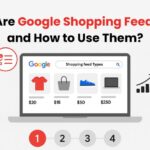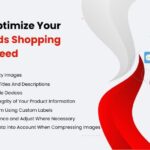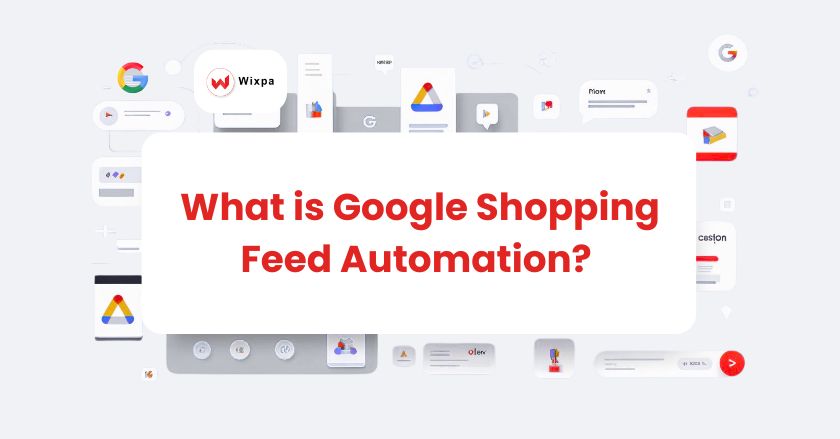
Want to grow your sales without all the manual work? Google Shopping feed automation simplifies managing and updating product feeds by using tools to optimize and automatically submit data to GMC.
Managing product data for Google Shopping often feels overwhelming. It requires careful attention to various details. These include product images, GTINs, unique IDs, and more. For some people, completing this process can take years of effort. However, there is a more efficient way to handle it. You can simplify this entire process with feed automation.
Feed automation uses specialized tools or software to create and manage product data automatically. This method eliminates many repetitive tasks. It also enhances overall efficiency when working with product feeds. By embracing automation, you save time and improve accuracy in managing your listings.
In this blog, you will learn about feed automation and how it operates. We will also discuss its essential elements and prerequisites. So, are you prepared to find out more? Let’s begin!
What Is Google Shopping Feed Automation?
Shopping feed automation uses automated processes to manage and update your product feed for Google Shopping. Instead of handling everything manually, you rely on specialized tools or services that simplify feed creation, optimization, and submission to the Google Merchant Center.
The main objective is to keep your product listings accurate, fresh, and fully compliant with Google’s feed requirements. This also helps ensure your listings are well-optimized for search queries, boosting their visibility.
Feed automation makes the entire process much easier. You can manually upload a file directly to Google Merchant Center. Alternatively, you can choose a product feed management app to handle everything seamlessly.
For example, apps like Wixpa automatically sync and manage your Shopify product data. These tools integrate with GMC, allowing you to run various ad types without extra effort. They include Search Ads, Display Ads, and YouTube Ads.
Key Requirements for Shopping Feed Automation:
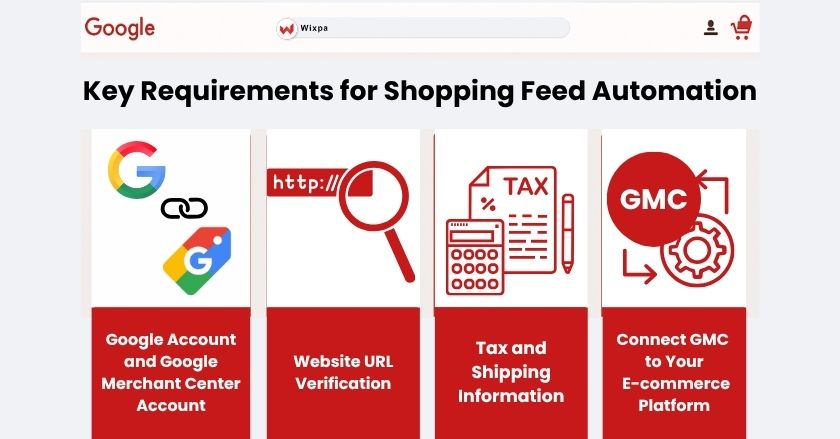
To automate your product feed, you must set up a few important things first.
1. Google Account and GMC
Ensure you have both a Google Account and a Google Merchant Center account ready.
Google Account
Go to your Google account and log in, or make a new one if necessary. After logging in, link this account to your Merchant Center.
Google Merchant Center
If you do not have a GMC account, create one. During setup, you must provide:
- Your business name
- The country where your business operates
- Your preferred time zone
Planning these details will make the process smoother.
If you manage multiple accounts, ensure your multi-client account (MCA), also known as an advanced account, is properly set up. Verify that all sub-accounts are correctly configured.
2. Website URL Verification
You need to verify your website URL to link your product data with the Merchant Center. After verifying, claim the URL as your own.
Important Points:
- Only one Merchant Center account can use a specific URL.
- URL verification grants you administrative control over the website.
This step is essential for building a connection between your site and the Merchant Center.
3. Set Up Tax and Shipping Information
Prepare your tax and shipping settings in advance.
Why This Matters:
- Accurate tax rates and shipping details ensure your product data follows Google’s guidelines.
- Missing or incorrect information can cause errors when submitting your feed.
4. Connect Merchant Center to Your E-commerce Platform
Finally, you need to link your Merchant Center to your chosen e-commerce platform.
If you use Shopify, the Shopify admin panel allows direct integration with the Merchant Center. This lets you sync product listings automatically.
Many e-commerce platforms offer apps and tools to help with this integration. Using them simplifies the process and keeps your store connected properly.
Ready to Automate Your Feeds?
Once these steps are complete, you’re prepared to harness the power of automated feeds. This will make managing your product data faster and more efficient.
Essential Components of Google Shopping Feed Automation:
Automated shopping feed simplifies and optimizes product data management for e-commerce businesses. It helps merchants easily manage correct and current product feeds by automating many operations. Let’s dissect its main components in simple and clear terms:
1. Automated Data Syncing
With feed automation, product data across platforms stays updated automatically. These tools pull data from your online store, such as Shopify. Then, they send it to destinations like Google Merchant Center. Whenever you modify product information, the system syncs changes in real time. This removes the hassle of manual adjustments, making your listings consistently accurate and reliable for buyers.
2. Built-In Optimization Tools
Many feed automation systems include powerful optimization features. These tools improve product titles, descriptions, and other listing details. Enhanced content makes your ads more appealing, boosting their visibility and performance. Better-optimized ads lead to higher click-through rates and increased sales opportunities.
3. Error Detection and Automatic Fixes
One of the biggest advantages of automation is its ability to spot and fix feed errors. Issues like missing product descriptions or incorrect formats are detected early and corrected without manual effort. You ensure your ads keep running smoothly without interruptions by preventing problems that could lead to Google Shopping disapprovals or account suspensions.
4. Scheduled Updates for Data Accuracy
Scheduling updates is another crucial feature. Automated updates ensure product prices, stock availability, and other key data remain current. By setting regular update intervals, you avoid outdated information, saving time and minimizing errors that could hurt customer trust.
In short, feed automation allows you to streamline workflows, reduce errors, and improve ad performance, making your eCommerce operations more efficient and effective.
Simplifying Shopping Feed Automation with Online Tools:
You can boost your online store’s visibility by integrating an e-commerce platform with the Merchant Center. This connection makes syncing product feeds smoother and helps you run successful campaigns effortlessly.
Many platforms provide feed management tools to streamline automation. These tools save time, boost productivity, and improve the overall process. They act as a reliable extra hand, optimizing your product feeds and driving more sales.
One standout solution is Wixpa Google Shopping Feed, a specialized feed management app designed for Shopify users. It removes the need for manual uploads to the Google Merchant Center. Instead, it automatically synchronizes your product feed with the Merchant Center, reducing tedious tasks.
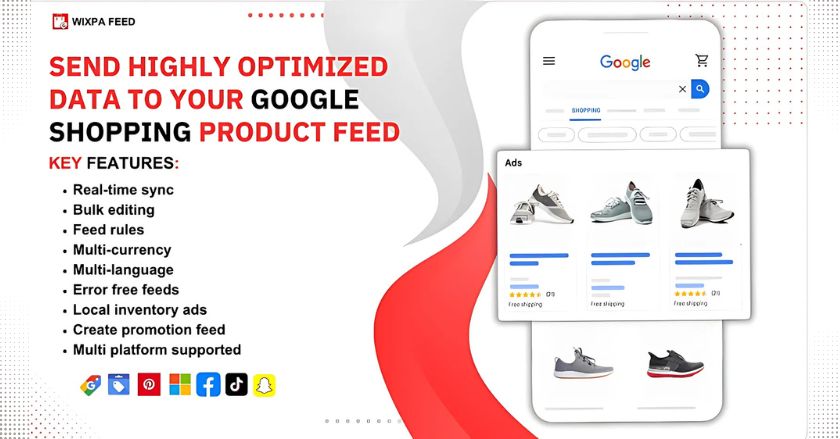
The app generates product feeds and refreshes them every 24 hours to maintain up-to-date and accurate information. These feeds are crafted to meet Google’s strict guidelines and adjust frequently to reflect any changes in your store’s data.
Customization options add flexibility for syncing. Although 24-hour updates are standard, merchants can opt for faster updates, including hourly or instant synchronization, based on their subscription plan.
This app significantly minimizes the steps required to create and synchronize feeds across platforms by automating the shopping feed. Any modifications you make to your product data are instantly reflected in the Merchant Center. The application guarantees that the data about your product is sent in the right format and meets all data attribute specifications.
Tips for Optimizing Your Google Shopping Feed
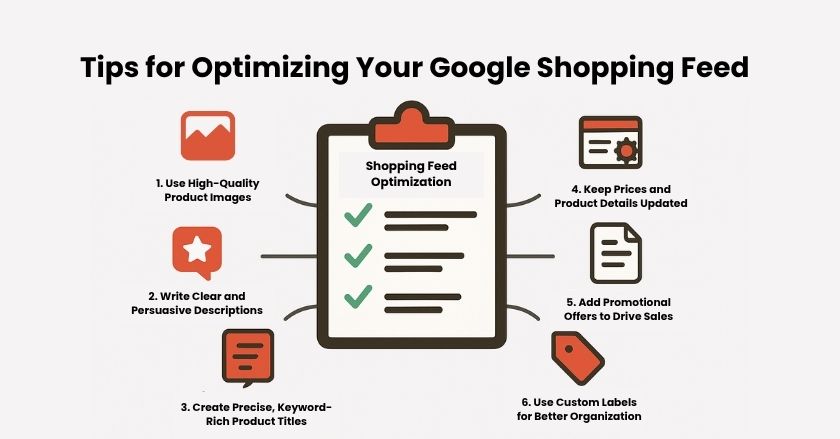
1. Use High-Quality Product Images
Choose bright and clear images to grab attention. Ensure the products are well-lit, sharp, and focused. Quality images help your listings stand out.
2. Write Clear and Persuasive Descriptions
Highlight the key features of each product. Use simple, engaging language that appeals to customers. Naturally, add primary keywords to boost search rankings and interest.
3. Create Precise, Keyword-Rich Product Titles
Write concise product titles with relevant keywords. Include details like brand, size, or color for better searchability. Descriptive titles help search engines find your products faster.
4. Keep Prices and Product Details Updated
Frequently update your product prices and information. Ensure your shopping feed matches your website’s details. This builds trust and prevents customer frustration.
5. Add Promotional Offers to Drive Sales
Include special offers and discounts to attract buyers. Promotions increase visibility and boost conversion rates.
6. Use Custom Labels for Better Organization
Organize products with custom labels. Group them by performance, season, or promotions. This improves ad targeting and helps manage campaigns more effectively.
Avoid These Common Mistakes:
1. Providing Low-Quality Product Data
Incomplete or poor-quality product data hurts visibility. Avoid vague descriptions and weak titles. Use clear, keyword-rich content to make your products easier to find.
2. Not Updating Inventory Regularly
A typical mistake is not regularly updating your inventory. Customers may become frustrated if you list things that are out of stock. Your reputation and account performance may suffer as a result of this encounter.
3. Ignoring Google’s Guidelines
Google has strict rules for product images, prices, and shipping info. If these rules are broken, listings can be denied or your account may be suspended. Always check twice to ensure you adhere to Google’s guidelines.
4. Skipping Feed Performance Analysis
Overlooking data analysis is a costly mistake. Reviewing feed metrics helps refine strategies and improve targeting. Regular analysis expands your reach and boosts potential sales.
Use Wixpa Shopping Feed for Automation:
Merchants love Wixpa Shopping Feed for its simple and user-friendly design. It makes managing Google product feeds easy, even for users without technical skills. The app’s automation keeps product listings accurate and regularly updated. It also supports multi-language feeds, helping businesses reach customers across different countries.
Many users report increased sales and better visibility on Google Shopping after using this app. They also highlight its exceptional customer support. The team is known for being quick to respond, knowledgeable, and ready to help with any issues.
Wixpa Google Shopping Feed is a significant app for e-commerce success because of its robust features and consistent support.
Conclusion
In short, Google shopping feed automation simplifies how your product feeds are updated. It uses automated methods to add feeds quickly and efficiently. This saves you time and helps you keep your product data accurate and up-to-date without extra effort.
Now is the perfect time to explore the automated shopping feed. Learn how it works and harness its power to boost your online business and reach greater success.



